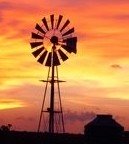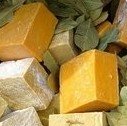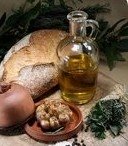Saponification Chart for Soap Making
A saponification chart or saponification table takes out the guesswork of soap making and wondering how much lye or caustic soda, also known as sodium hydroxide, you should be adding to each type of fat that you decide to use. Elaine White, the American Soapmaker, is responsible for the following chart.
Knowing the exact amount of caustic soda or sodium hydroxide should be added to the different oils or fats that you may use is important, because if you add too much, it could burn your skin. If you add too little, your soap will contain excess fat which will cause your soap to go rancid.
Use the following saponification saponification chart or table for making soap by multiplying the number of grams of oil or fats by the figure stated and this will give you the exact amount of sodium hydroxide to saponify it. For example, if you are going to use 150 g of sunflower oil or olive oil, multiply 150 x 0.134 which will give you 20.1 grams. You can round up or down your numbers accordingly, and therefore I would only add 20 grams of sodium hydroxide or caustic soda to the sunflower or olive oil to get the correct balance and to saponify your soap.
If you are working in ounces, follow the same process, using the figures on the saponification chart but the amount of sodium hydroxide you will need will be expressed in ounces. Therefore 16 oz of sunflower or olive oil will be multiplied by 0.134 resulting in 2.1 oz of sodium hydroxide. Add 2 oz of caustic soda to your soap.
If you are using more than one type of oil in a single soap recipe, do the above step for each oil used on the saponification chart and then total your results together to get the total amount of lye needed. By using the saponification chart learning how to make soap suddenly became a whole lot easier!
* Don't forget to use sodium hydroxide listing for making hard soaps and potassium hydroxide for making liquid soaps.
* The term lard on the saponification chart is pig fat.
|
Oil
|
Hydroxide (NaOH) |
Potassium |
|
Hydroxide (NaOH) |
|
| Apricot Kernel | 0.1350 | 0.1890 | Maize | 0.1360 | 0.1904 |
| Arachis | 0.1360 | 0.1904 | Mink | 0.1400 | 0.1960 |
| Avocado | 0.1330 | 0.1862 | Mustard | 0.1241 | 0.1737 |
| Babassu, Brazil nut | 0.1750 | 0.2450 | Neat's foot | 0.1359 | 0.1902 |
| Beef Hoof | 0.1410 | 0.1974 | Neem | 0.1387 | 0.1941 |
| Beeswax, White | 0.0690 | 0.0966 | Niger-seed | 0.1355 | 0.1897 |
| Brazil Nut | 0.1750 | 0.2450 | Nutmeg Butter | 0.1160 | 0.1624 |
| Butterfat, Cow | 0.1619 | 0.2266 | Olium Olivate | 0.1340 | 0.1876 |
| Butterfat, Goat | 0.1672 | 0.2340 | Olive | 0.1340 | 0.1876 |
| Canola | 0.1240 | 0.1736 | Palm Butter | 0.1560 | 0.2184 |
| Castor | 0.1286 | 0.1800 | Palm Kernel | 0.1560 | 0.2184 |
| Chicken Fat | 0.1389 | 0.1944 | Palm | 0.1410 | 0.1974 |
| Chinese Bean | 0.1350 | 0.1890 | Peanut | 0.1360 | 0.1904 |
| Cocoa Butter | 0.1370 | 0.1918 | Perilla | 0.1369 | 0.1916 |
| Coconut | 0.1900 | 0.2660 | Poppyseed | 0.1383 | 0.1936 |
| Cod-liver | 0.1326 | 0.1856 | Pumpkinseed | 0.1331 | 0.1863 |
| Coffee-seed | 0.1300 | 0.1820 | Ramic | 0.1240 | 0.1736 |
| Colza | 0.1240 | 0.1736 | Rape | 0.1240 | 0.1736 |
| Corn | 0.1360 | 0.1904 | Rapeseed | 0.1240 | 0.1736 |
| Cottonseed | 0.1386 | 0.1940 | Rice Bran | 0.1280 | 0.1792 |
| Earthnut | 0.1360 | 0.1904 | Ricinus | 0.1286 | 0.1800 |
| Flaxseed | 0.1357 | 0.1899 | Safflower | 0.1360 | 0.1904 |
| Florence, aka Olive | 0.1340 | 0.1876 | Sesame Seed | 0.1330 | 0.1862 |
| Gigely Tree | 0.1330 | 0.1862 | Shea Butter | 0.1280 | 0.1792 |
| Goose Fat | 0.1369 | 0.1916 | Shortening (veg.) | 0.1360 | 0.1904 |
| Grapeseed | 0.1265 | 0.1771 | Soybean | 0.1350 | 0.1890 |
| Hazelnut | 0.1356 | 0.1898 | Sunflower Seed | 0.1340 | 0.1876 |
| Hemp Seed | 0.1345 | 0.1883 | Sweet Oil | 0.1340 | 0.1876 |
| Java Cotton | 0.1370 | 0.1918 | Tallow, bear | 0.1390 | 0.1946 |
| Jojoba | 0.0690 | 0.0966 | Tallow, beef | 0.1405 | 0.1967 |
| Kapok | 0.1370 | 0.1918 | Tallow, chinese vegetable | 0.1345 | 0.1883 |
| Karite Butter (Shea) | 0.1280 | 0.1792 | Tallow, deer | 0.1379 | 0.1930 |
| Katchung | 0.1360 | 0.1904 | Tallow, goat | 0.1383 | 0.1936 |
| Kukui Nut | 0.1350 | 0.1890 | Tallow, sheep | 0.1383 | 0.1936 |
| Lanolin | 0.0741 | 0.1037 | Teal/Teel/Til | 0.1330 | 0.1862 |
| Lard | 0.1380 | 0.1932 | Theobroma | 0.1370 | 0.1918 |
| Linseed | 0.1357 | 0.1899 | Tung | 0.1377 | 0.1927 |
| Loccu | 0.1340 | 0.1876 | Walnut | 0.1353 | 0.1894 |
| Macadamia | 0.1390 | 0.1946 | Wheatgerm | 0.1310 | 0.1834 |
Now that you have the saponification chart under your belt visit our Making Soap page for more information on how to make soap at home. You will also find Soap Recipes for the three main types of soaps; hand-milled soaps where you do not have to use raw lye, cold process and hot process soaps.
Did you find this page helpful?
Sharing is a way of saying, "Thanks!"
Follow Us and Keep Up to Date
Other Resources that you May be Interested In
Go from Saponification Chart to Making SoapGo to Soap Recipes
Go to Homemade Laundry Soap Detergent
Go to Make Lye from Wood Ash
Go to Country Crafts
Go to Country Living
Go to Self-Sufficient Living
Go to Frugal Living






New! Comments
Do you have something of value to add? Leave me a comment in the box below.